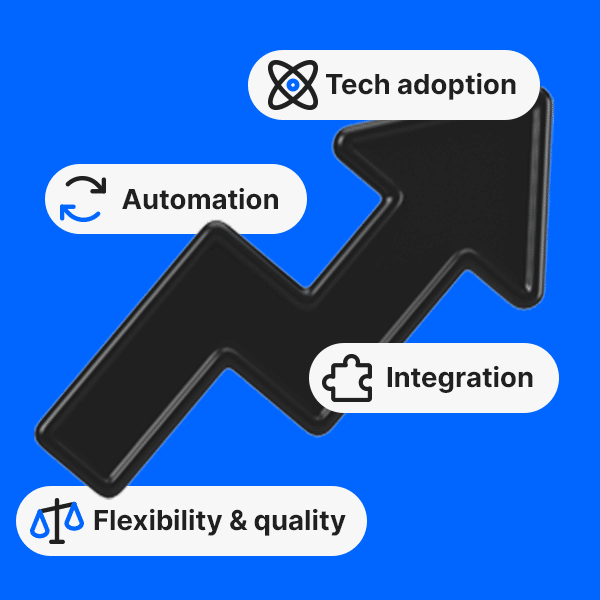Investing in an automated enterprise solution is a big decision, one that can impact aspects of your operations well beyond its immediate function. A global payroll solution, for example, can affect processes in HR, Finance, IT and even Sales. As you consider your options, it becomes clear that a key to unlocking the full potential of any system is integrating it with your existing solutions.
But integrating an enterprise application with current systems can be a tricky process. Before deciding whether it’s the right move for your organization, you must ask which systems should be integrated, when, how, for how much— and a host of other nerve-wracking questions. Understanding costs and analyzing benefits can be time-consuming, and budgets and schedules are usually tight or inflexible.
Yet, integration doesn’t have to be a struggle. The following five best practices can help you manage costs, schedules and expectations to ensure a smooth, effective payroll integration that will support your goals and organization into the future.
1. Understand Your Starting Point
Before you can determine whether an integrated payroll solution is right for your organization, you must gather, quantify and understand the details of your existing process. Collect information about current costs, including application licenses and processing fees, as well as any required middle-ware. You need to understand the data being handled, where it’s going, who’s transferring it, the average changes in each cycle and any related hard and soft costs, such as additional fees for data changes or extra hours spent reconciling errors.
It is also important to speak with those involved at each step of your payroll process to discover pain points, opportunities for improvement or hidden issues that an integration could resolve. A comprehensive, clear picture of your current payroll situation will help make your best case for integration and be an important reference throughout the project.
2. Have A Clear Business Case
From the perspective of process optimization and control, integrating applications almost always makes sense. It can minimize errors, eliminate dual entry, enable easier reconciliation and more. However, making a business case for integration can be far more complicated.
Luckily, you have spent valuable time developing a comprehensive understanding of your existing payroll process and thereby already know the cost of non-integration. Now it’s time to identify the desired benefits of payroll integration and estimate prices (both as one-time upfront costs and spread over the duration of your application contracts), so you can evaluate if an integration project makes sense for your organization. Your business case must clearly lay out the expected outcome and benefits of the integration, as well as projected costs and contingencies. The key as you progress through integration is to consistently refer back to the business case to make sure your stated goals are being achieved.
3. Invest In Project Management
An effective, dedicated project manager can mean the difference between a successful, in-scope integration and a cautionary tale. Investing in project management can ensure you retain control over the project and gain all intended benefits. Whether from an in-house source, a hired consultancy or through a certified integration, where your application vendors do the work for you, the role and benefits of a project manager are the same.
Using the business case as their integration blueprint, the project manager will assess and prioritize needs, identify and involve the correct stakeholders as necessary, maintain and report on the schedule, and oversee the budget. Large-scale payroll integrations can take the better part of a year and require a lot of work, time and other resources most employees can’t spare. Having one person assigned to manage and deliver the complete project can keep your integration on track.
4. Have A Clear Project Plan
A straightforward, actionable project plan serves as your roadmap to successful global payroll integration. The project manager will outline the progression of steps to take, including deadlines, durations, responsible parties, expectations, contingencies and the resources needed. Every step should have an owner, a clear goal and a deadline, and the plan should be laid out so that everyone involved can see and understand the entire journey.
Key to a good project plan is a comprehensive resource plan. The time, money, labor and items needed for each step should be accounted for ahead of time to help make sure they’re available and on-hand when needed. Your project manager should give regular progress reports according to the project plan, keeping all relevant parties informed and involved.
5. Get An Executive Sponsor
The value of a project sponsor at the executive level can be easily overlooked, especially in projects that run smoothly. However, this person can be indispensable when tough decisions need to be made, reluctant stakeholders must be engaged or unanticipated changes threaten the project.
The right executive sponsor will understand and support the business case, and can help the project manager move through any challenge. Their day-to-day involvement can vary widely depending on a project’s needs and timeframe; however, their value isn’t linked to the hours they log, but rather the weight their attachment gives to the project and the team.
Integrating your global payroll solution with other applications, such as HR, can yield tremendous benefits in terms of cost savings, improved compliance, data security and more. However, integration can be a long, expensive and involved process. It’s essential to understand the potential outcomes and possible obstacles well ahead of time.
Following these five best practices will help you address issues and alleviate concerns, giving you greater confidence throughout the planning and execution of your payroll integration.


